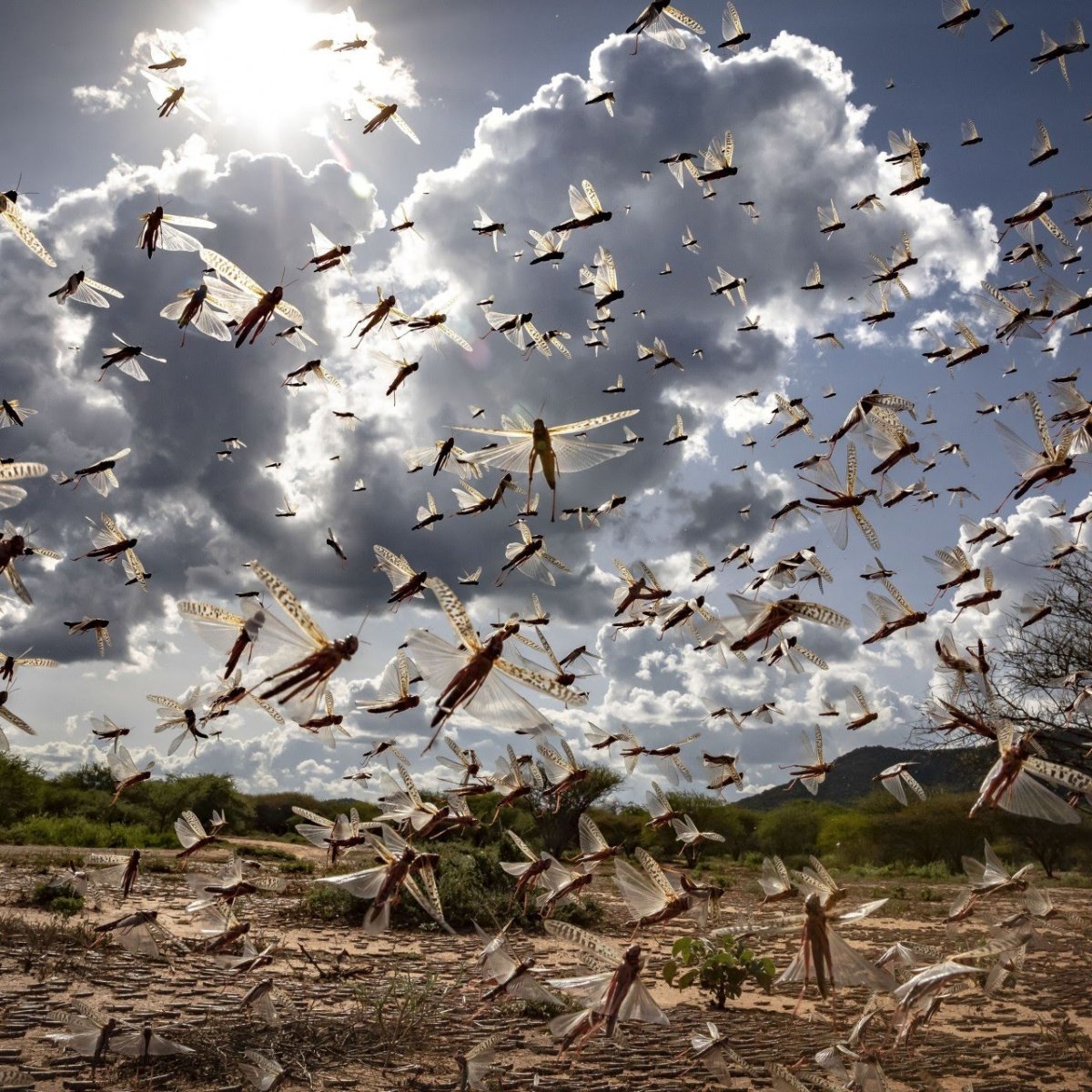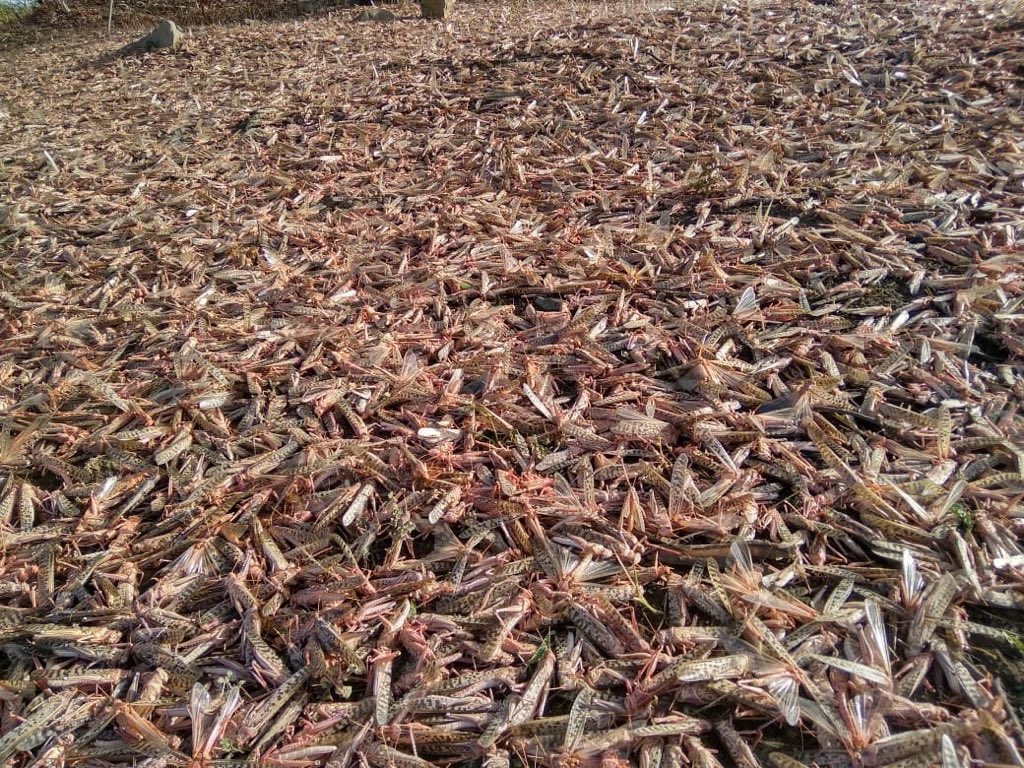Why Are Deadly Locusts Swarming India? An Expert Reveals The Answer
Locust swarms can eat the food of up to 35,000 people in a single day. The situation is indeed alarming amidst the coronavirus but it can be controlled with rapid actions

With The Positive Collective, The Better India’s COVID-19 coverage is available to regional language publications for free. Write to [email protected] for more details.
After leaving a devastating trail in Gujarat, Madhya Pradesh, and Rajasthan, swarms of desert locusts have entered the Vidharbha region of Maharashtra.
Part of the grasshopper community, desert locusts feed on crops and plantations every year from July to October. They are mostly spotted in small isolated groups.
However, due to climate change, these migratory insects are causing unprecedented damage in several parts of India.
“This kind of rapid and massive attack was witnessed in 1993, nearly 27 years ago. Predicting how many locusts can enter the region is difficult, given the lack of pattern of such incidents and the uncertainty of rainfall in locust areas. So, our solutions largely lie in controlling the attack through spraying pesticides,” says A M Bharia. He is a Plant Protection Officer from the Locust Warning Organisation.

Known as the most dangerous migratory insects in the world, desert locusts are a part of the grasshopper community. They are different from the usual grasshoppers as they can change their behaviour and habits and migrate over large distances.
With two big hind legs, these insects move in large groups and eat crops weighing their own weight daily, which is up to two grams.
As per a report, locusts have already wiped out five lakh hectares of farms in Rajasthan in the last three months, affecting the livelihoods of hundreds of farmers.
Locust swarms now invade India. This from Jaipur in Rajasthan yesterday pic.twitter.com/IzOtposTUu
— Channa Prakash (@AgBioWorld) May 26, 2020
Likewise, Gujarat, Madhya Pradesh, and Uttar Pradesh have been reeling under similar situations for some months now. In December 2019, locusts had destroyed crops spread over 25,000 hectares in Gujarat.
The size of locust swarms can vary up to one square kilometre and contain up to 80 million locusts, which can eat the food of up to 35,000 people in a single day according to the Food and Agriculture Organisation (FAO) of the United Nations.
Explaining the repercussions on farmers, Bharia adds, “Farmers have always been at the receiving end of such natural calamities and they are worst sufferers in locust attacks. It is going to leave them with heavy crop and financial losses.”
They come together in dry spells to feed on humongous vegetation within days and reproduce rapidly during the rains. “A solitary female lays about 95-158 eggs, whereas a gregarious female lays usually less than 80 eggs in an egg pod. Females can lay at least three times in their lifetime, usually at intervals of about 6-11 days. Up to 1,000 egg pods have been found in one square metre,” says the FAO.
The nationwide lockdown due to COVID-19 has already threatened the food and economic security of farmers, and the intensifying locust attacks have raised alarms, giving them nightmares.
The Central government already issued warnings to the affected states and sent an alert to Delhi last week.
Invasion In India & Spread

Desert locusts are native to African countries and the Arabian Peninsula. They migrate to Iran and Pakistan in search of greenery and moisture and then arrive in India.
However, the locusts found favourable conditions for reproduction in the Arabian Peninsula in 2018 in the wake of two consecutive cyclones (Mekunu and Luban). Their numbers increased significantly and thus began the migration outbreak.
After destroying nearly 40 per cent of crops in Pakistan last April, the desert locusts entered India in 2019 in the wake of heavy rains and cyclones.
“The outbreak started after heavy rains over East Africa and the Arabian Peninsula. Heavy rain triggers the growth of vegetation in arid areas where desert locusts can grow and breed. On top of that, the rising temperatures due to global warming made the Western Indian Ocean particularly warm,” Roxy Mathew Koll told Hindustan Times. He is a climate scientist at the Indian Institute of Tropical Meteorology (IITM) in Pune.
What Can Be Done
Swarms of Locusts enter Jhansi, Uttar Pradesh.
Environment Ministry yesterday said, Locust Swarm from Pakistan have entered Rajasthan, Punjab, Haryana and Madhya Pradesh threatening major damage to crops.
Report:Vikas Kumar pic.twitter.com/OECWrfCjbL
— All India Radio News (@airnewsalerts) May 23, 2020
“A strict round-the-clock vigilance and spraying of pesticides or organophosphate chemicals is a fundamental step to control the locusts. It has to be applied in small concentrated doses (referred to as ultra-low volume- ULV) through aerial and on-ground vehicles or sprayers,” informs Bharia.
As per the government’s contingency plan, Malathion 96 per cent ULV is always kept in stock of 5,000 litres. Around one litre of the chemical can treat a hectare.

“According to their behaviour patterns, locusts settle during the night, mostly only on trees, and that is when pesticides have to be sprayed. Vehicle-mounted sprayers (with up to 100 litres of capacity) go around in the field and spray. We also rope in farmers who have tractor-operated sprayers. In addition to this, fire brigades are also kept ready as they can cover huge trees,” Bharia explains.
The nature of the attack is extremely deadly this year, and to fight this, India will use drones and planes for the first time, says B R Karwa, project director, Agricultural Technology Management Agency.
Meanwhile, the FAO has predicted that the attack is going to swell in the coming weeks. Close to 45 million sq km of land in 90 countries are under an invasion threat by the desert locust. In such precarious times, we hope chemicals and pesticides will be enough. However, in the long term, a comprehensive plan to prevent sudden and extreme climate change will be imperative.
Featured Image Source
(Edited by Shruti Singhal)
Like this story? Or have something to share?
Write to us: [email protected]
Connect with us on Facebook and Twitter.
If you found our stories insightful, informative, or even just enjoyable, we invite you to consider making a voluntary payment to support the work we do at The Better India. Your contribution helps us continue producing quality content that educates, inspires, and drives positive change.
Choose one of the payment options below for your contribution-
By paying for the stories you value, you directly contribute to sustaining our efforts focused on making a difference in the world. Together, let’s ensure that impactful stories continue to be told and shared, enriching lives and communities alike.
Thank you for your support. Here are some frequently asked questions you might find helpful to know why you are contributing?


This story made me
-
97
-
121
-
89
-
167











